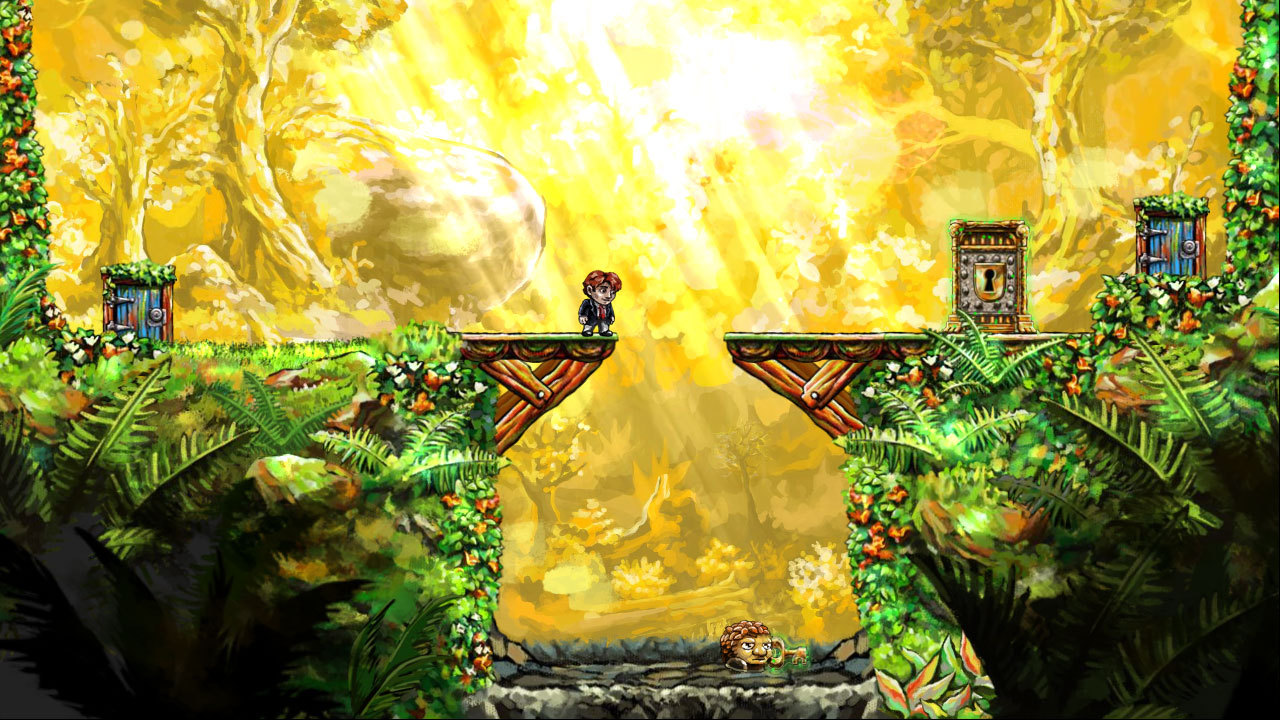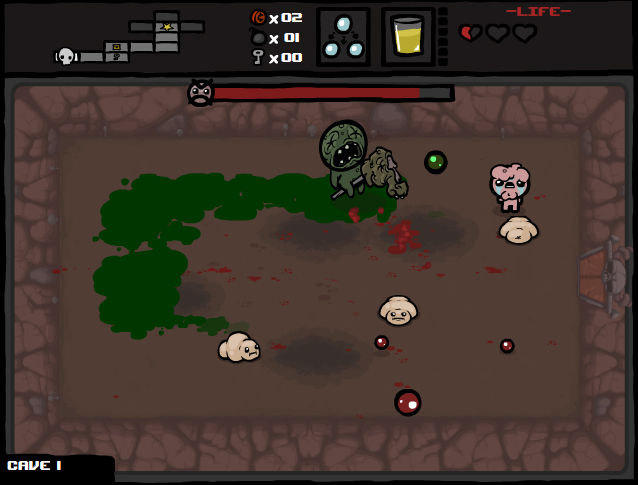Before further examining this, we'll need to know what defines a (2D-)'platformer'. I'd say it's the side-view perspective in combination with gravity affecting the players game avatar and constraining his movement to maneuvering 'platforms'. That's far from a waterproof definition, but I think it will do for now. I'll take a look at these two aspects (visuals and mechanics) separately.
Visuals
Generally speaking, a side-view perspective is visually more appealing to the player than a top-down view, I think. It's closer to the perspective humans live in every day. We're not used to looking at things from above. Hence, we tend to have more trouble recognizing objects from a bird's eye view. Relating to actors in the game world becomes much harder without seeing their face. For top-down games with non-abstract settings, this can be a big problem.
One might argue that this problem can be solved by using an isometric or axonometric perspective. It means showing objects from an angle (e.g. Bastion) or even in full side-view (e.g. The Binding of Isaac), while still keeping the top-down gameplay. While it works fine for some games, it can bring its own problems. Not only do isometric visuals mean way more work for art and level-design; shifting the perspective like that can make collision boxes much harder to read for the player, which is crucial for action-heavy and precise gameplay.
One might argue that this problem can be solved by using an isometric or axonometric perspective. It means showing objects from an angle (e.g. Bastion) or even in full side-view (e.g. The Binding of Isaac), while still keeping the top-down gameplay. While it works fine for some games, it can bring its own problems. Not only do isometric visuals mean way more work for art and level-design; shifting the perspective like that can make collision boxes much harder to read for the player, which is crucial for action-heavy and precise gameplay.
Gameplay
Now, this is the most interesting bit in my opinion. Why use the rules of a platformer (gravity) when your core game idea does not require it?
Being somewhat of a 'game-mechanics purist', I've been having a hard time answering this one. My first impulse was to say: "If you don't need it, don't use it. Platforming in itself is an added mechanic that will distract players from the actual core gameplay."
Then I did some thought-experiments: I picked a couple of mechanics-driven games I recently played and tried to imagine them inside a different perspective. And I noticed that while most of them would theoretically work in a top-down environment, different features would have to be introduced to replace the missing platforming-mechanics.
Let's take Braid as an example. It's core mechanic is letting the player rewind time at any point in the game. That would work in a top-down environment, right? Sure. But let's try to recreate a typical moment from the game in this new perspective: The player falls into a pit he cannot jump out of, so the player rewinds time to get back out. Not a complex scenario really, and still demonstrates the core mechanic perfectly. So, what would the equivalent be top-down? We'll need to create a situation in which the player is somehow trapped because he made a mistake, and can not undo it without rewinding time. You can try finding one for yourself; I think it's a really good design exercise.
For obvious reasons, falling into a pit doesn't really work here. How about one-way doors, which the player can only walk through from one side? If the player walks through a wrong door, he can not get back and has to rewind time. It would demonstrate the principle, I guess. But on top of being way less satisfying for the player (reverse walking looks way lamer than reverse falling), it would also require additional mechanics (one-way doors). I just couldn't find any scenario as simple and elegant as falling into a pit. (If you did find one, please let me know. I'd love to hear it!)
This was only an example, but I tried this with many games and many scenarios and rarely ever found a suitable replacement.
What it made me realize is that a core mechanic can rarely ever exist in a void. It almost always needs a framework of secondary mechanics to be properly conveyed. So the alternative to using established platforming mechanics is using other mechanics which are more complex and less self-explanatory. Gravity is such a universally recognized and understood principle that it can be used to explain the not-so-universally-understood principles that may be your game's core mechanics.
Now, this is the most interesting bit in my opinion. Why use the rules of a platformer (gravity) when your core game idea does not require it?
Being somewhat of a 'game-mechanics purist', I've been having a hard time answering this one. My first impulse was to say: "If you don't need it, don't use it. Platforming in itself is an added mechanic that will distract players from the actual core gameplay."
Then I did some thought-experiments: I picked a couple of mechanics-driven games I recently played and tried to imagine them inside a different perspective. And I noticed that while most of them would theoretically work in a top-down environment, different features would have to be introduced to replace the missing platforming-mechanics.
Let's take Braid as an example. It's core mechanic is letting the player rewind time at any point in the game. That would work in a top-down environment, right? Sure. But let's try to recreate a typical moment from the game in this new perspective: The player falls into a pit he cannot jump out of, so the player rewinds time to get back out. Not a complex scenario really, and still demonstrates the core mechanic perfectly. So, what would the equivalent be top-down? We'll need to create a situation in which the player is somehow trapped because he made a mistake, and can not undo it without rewinding time. You can try finding one for yourself; I think it's a really good design exercise.
 |
| A pit in Braid (just pretend there wasn't an enemy with a key in it) |
For obvious reasons, falling into a pit doesn't really work here. How about one-way doors, which the player can only walk through from one side? If the player walks through a wrong door, he can not get back and has to rewind time. It would demonstrate the principle, I guess. But on top of being way less satisfying for the player (reverse walking looks way lamer than reverse falling), it would also require additional mechanics (one-way doors). I just couldn't find any scenario as simple and elegant as falling into a pit. (If you did find one, please let me know. I'd love to hear it!)
This was only an example, but I tried this with many games and many scenarios and rarely ever found a suitable replacement.
What it made me realize is that a core mechanic can rarely ever exist in a void. It almost always needs a framework of secondary mechanics to be properly conveyed. So the alternative to using established platforming mechanics is using other mechanics which are more complex and less self-explanatory. Gravity is such a universally recognized and understood principle that it can be used to explain the not-so-universally-understood principles that may be your game's core mechanics.
